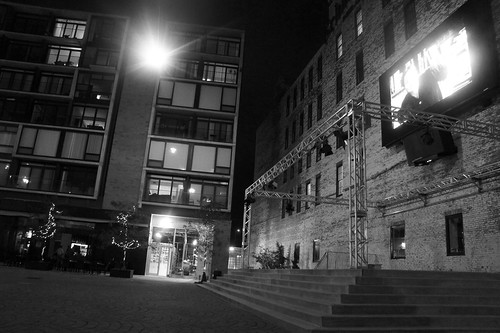
As a part of its Fall 2011 public programs and exhibitions, the University Libraries hosted a screening on Sept. 13.
A young man climbs a narrow metal ladder to his designated perch, a small platform just below the ceiling of the Philadelphia Spectrum. Underneath him the sounds of skates slicing through ice echo throughout the stadium as the Philadelphia Flyers cut around the rink. Suddenly, the screams and cheers of the crowd fill the air. It is time for the man to get to work. He turns to the organ sitting in front of him and plays a song of the popular genre at the time–disco, of course.
The organ player, Alan Paller, is just one of the many unique musicians featured in Temple University Libraries’ latest film collection, “Philadelphia: Sound and Vision,” which aired at the Piazza at Schmidts last Tuesday.
The collection, put together by the library’s urban archives, highlights Philadelphia musicians using WPVI and KYW footage from 1947 to the early 1980s.
The film is essentially a visual history of the Philadelphia music scene, featuring performers such as David Bowie, McFadden & Whitehead, Sun Ra, Kenn Kweder, Khan Jamal, the Mummers and the Philadelphia Orchestra.
All of the footage used in the film was donated to the urban archives in order to be digitized, organized and used by students, researchers and documentary filmmakers.
John Pettit, an assistant archivist at the Temple is very familiar with the digitization and organization process, as he co-curated the footage used in “Sound and Vision” with Kathryn Gronsbell.
Stepping into Pettit’s office is like stepping into a media museum, filled with cans of 16mm film, a few very large two-inch film rolls and even one or two VHS tapes, all of which are now nearly unrecognizable technologies.
The idea for “Sound and Vision” came about while doing preservation work on these recording methods of the past, according to Pettit.
“I just started to notice and take out things that I saw about music and sound,” Pettit said. “I chose many of the quirky things like the Mummers and other distinct people who are lesser known. It is not about defining what music is in Philadelphia. It is about showing the small pockets of music.”
The music theme in the film kicks off a semester of similarly oriented events to be sponsored by Temple University Libraries. These will include talks given by Sara Marcus, author of “Girls to the Front: The True Story of the Riot Grrrl Revolution,” Larry Magid, one of the founders of the Electric Factory and George Miller, the founding editor of JUMP: The Philly Music Project.
“Music is something everyone can relate to,” Nicole Restaino, manager for communications and public programming with the library, said. “It is a way to connect history and literature and pop culture.”
“Sound and Vision” is indeed successful in connecting history and pop culture. The section of the film featuring rock and roll artist Kenn Kweder is indicative of that connection.
Footage of the young singer showed him dressed in a short black-and-white-striped robe and a pair of baggy pajama-like pants, long curly hair swaying in the wind as he sang. The fans around him went wild with every note and one fan even said that, “I think he’s the messiah.”
Kweder embodied the revolution against traditional values that took place in America throughout the late 1960s and 1970s in telling the reporter that, “I don’t need a can of Campbell’s soup and a ‘66 Chevrolet to make me happy. I just broke out of it. I said, ‘I’m not going to live like this.’”
“Sound and Vision” also connects music to African-American history through jazz musician Khan Jamal. Playing the xylophone with strong passion and emotion, Jamal encouraged African Americans to be proud of jazz and to force it into the mainstream.
“Jazz used to be played at poor houses, but people like [Duke] Ellington and [Louis] Armstrong worked hard to bring it legitimacy,” he said.
Other performers illustrated in the film are Sun Ra, the avant-garde jazz performer who spoke on stage wearing an outfit made entirely of sequins, and the Mummers, whose footage was shot without sound and entirely in black and white while spectators stood on apple crates to catch a glimpse of this time-honored Philadelphia tradition.
“What a wealth,” Corey Chao, one of the spectators said. “It’s humbling to sit down and look at a program and think about what is even in that archive. It’s the history of television.”
Quite a bit of the city’s history is stored within the urban archives, located in the basement of Paley Library. More than seven million news clippings and four million photographs from the Philadelphia Evening Bulletin, dating from 1920 to the early 1980s, are also stored there, along with an extensive series of manuscripts from a variety of different sources ranging from the Pennsylvania Railroad Company to the Philadelphia Special Investigation Commission.
“That is the great thing about archives,” Restaino said. “You get to search through them and find a lot of great things along the way–often better than what you were originally looking for.”
It is a combination of all of those interesting things that archivists find along the way that finally made it into “Sound and Vision,” creating an entertaining and visual history of music in Philadelphia.
“It’s all of the historical stuff that makes it so great,” Aislinn Pentecost-Farren, another spectator, said. “I mean, the Flyers had a live organist. That’s amazing. I wish they still had that.”
Amy Stansbury can be reached at amy.stansbury@temple.edu.



Be the first to comment